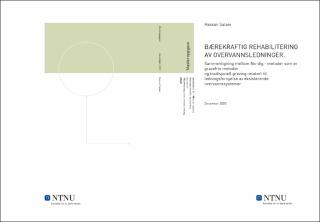| dc.contributor.advisor | Paste, Alex Klein | |
| dc.contributor.author | Salaei, Hassan | |
| dc.date.accessioned | 2021-09-20T16:26:43Z | |
| dc.date.available | 2021-09-20T16:26:43Z | |
| dc.date.issued | 2020 | |
| dc.identifier | no.ntnu:inspera:66672196:29616086 | |
| dc.identifier.uri | https://hdl.handle.net/11250/2779518 | |
| dc.description.abstract | Sammendrag
Formålet med masteroppgaven er å finne ut økonomiske fordeler og ulemper på prosjekt av overvannssystemet som har blitt rehabilitert med strømperenovering langs eller under hovedveier. Jeg har valgt prosjektet Hvam - Gardermoen i oppgaven. Prosjektet har blitt delt i tre etapper før renoveringsarbeidet startet. Statens vegvesen var byggherren.
Jeg har brukt en komparativ metode for å sammenligne kostnadsberegninger i prosjektet. All data som er benyttet i oppgaven, ble innhentet på de forskjellige etappene i prosjektet og fremstilt i forskjellige tabeller. Hvor stikkrenner har blitt rehabilitert med no-dig metoden. Prisen på strømperenovering er ferdig gitt i kontrakten og jeg simulerer hva det ville ha kostet hvis de hadde blitt rehabilitert med tradisjonell gravemetode. Kostnadsberegningene ble gjort i et excel ark som en gjennomsnittspris. Konkurransegrunnlaget ble utarbeidet for hver etappe, som er basert på NS 8406-standarden og prosjektene har brukt enhets priskontrakt. Kontrakts beskrivelse i prosjektene består av en standard og en spesiell beskrivelse. Standard beskrivelse gjelder Statens vegvesens håndbok nr. 025 "Prosesskoder fra 1 til 7 som omhandler veikontrakter. Kostnadsberegningene blir sammenlignet for begge metodene for å komme til et resultat.
Dette resultatet blir en differansekostnads verdi for enkelte stikkrenner i prosjektet. Analysene eller kostnadsberegningene ble utført på de 67 stikkrennene som var rehabilitert med strømperenovering i de tre forskjellige etappene.
Resultatene av analysene viser at kostnadene på prosjektet har blitt ca. 21 % billigere med strømperenovering i forhold til tradisjonell gravemetode. Tallene fra undersøkelsen avslører store økonomiske fordeler og ulemper ved bruk av no- dig metoden når stikkerennene ligger under eller langs veien.
Konklusjonen viser at disse to ulike metodene har sine fordeler og ulemper. No-dig metoden for rehabilitering med strømperenovering er avhengig av en rekke forhold, slik som tilstand på eksisterende rørledninger, beliggenhet, grøftedybde, grunnforhold, avstand til annen infrastruktur og korte og lange strekninger. I denne oppgaven har jeg identifisert de fire variablene.
Anbefalinger fra oppgaven: Det er viktig å vurdere begge metodene grundig i forprosjekteringsfasen og samtidig ta hensyn til enkelte variabler som beliggenhet, grøftedybde, grunnforhold og strekningens lengde. | |
| dc.description.abstract | Summary
The purpose of the master's thesis is to find out the economic advantages and disadvantages of projects regarding surface water systems that have been rehabilitated with No-dig renovation along or under main roads. I have chosen the project Hvam - Gardermoen in the thesis. The project was divided into three stages before the renovation work started. The Norwegian Public Roads Administration was the main builder.
I have used a comparative method to compare cost calculations in the project. All the data used in the thesis was obtained at the different stages of the project and presented in different tables. Where culverts have been rehabilitated with the no-dig method, the price of renovating the No-dig method is already given in the contract and I simulate what it would have cost if they had been rehabilitated with a traditional digging method. The cost calculations were made with an Excel sheet as an average price. The tender documents were prepared for each stage based on the NS 8406 standard, i.e. the projects used the contract type Unit price contracts. The contract description in the projects consists of a standard and a special description. The standard description applies to the Norwegian Public Roads Administration's handbook No. 025: (Håndbok nr. 025, 2012) "Process codes from 1 to 7 which deal with road contracts”. The cost calculations are compared for both methods to arrive at a result.
This result is a difference cost value for some culverts in the project. The analyses or cost calculations were performed on the 67 culverts that had been rehabilitated with no-dig method in the three different stages.
The results of the analysis show that the costs of the project have were approximately. 21% cheaper with the no-dig method compared to traditional digging method. The figures from the survey reveal major economic advantages and disadvantages of using the necessary method in economics when the culverts are below or along the road.
The conclusion shows that these two different methods have their advantages and disadvantages. The no-dig for rehabilitation with No-dig method renovation depends on a number of conditions, such as the condition at an existing pipeline, location, ditch depth, ground conditions, distance to other infrastructure and the length of distances – either short or long. In this thesis I have identified the different four variables.
Recommendations from the thesis are important to consider for both methods thoroughly in the pre-engineering phase and at the same time to take into account variables such as Location, ditch depth and ground conditions and length of the section. | |
| dc.language | | |
| dc.publisher | NTNU | |
| dc.title | BÆREKRAFTIG REHABILITERING AV OVERVANNSLEDNINGER | |
| dc.type | Master thesis | |
